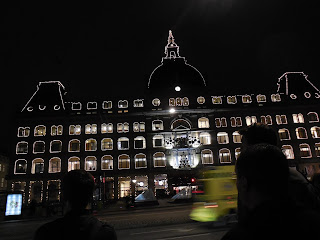We were off on the right path in no time at all. Blixen's home in Rungstedlund is just north of Copenhagen on the "thumb" of Denmark--Hovedstaden. Disembarking from the train, we immediately saw signs to the Karen Blixen house--a mere 1.1 km from the station.
As we were walking in the direction of the Museum, we were greeted by a couple who informed us the museum, cafe and gift shop were closed due to a meeting of the Danish Academy of Writers, but we were free to walk the grounds. We were seriously disappointed, but set off on our trek through the woods, regardless. This was the first time we've seen the sun in days, so it didn't make sense to sulk about it.
The Rungstedlund Park "covers an area of 16.6 hectacres,
and [most] of the grounds have been laid out as a bird sanctuary."
These bird houses apparently facilitate nesting by the bird species frequenting the park.
"There are also flower gardens where every day during the summer season fresh flowers are cut for decorating the house."
Eventually, we made our way to the front of the house.
Alexis volunteered to play the status card to see if we might gain access to the house because we are visiting scholars. She found a sympathetic young man who was playing along quite nicely, but he asked if we had an invitation to this event and she had to answer truthfully. Strike two.
The house is situated with a lovely view of the water in front,
and the wonderful grounds in the back.
Before leaving the property, we sought out Blixen's grave (she died in 1962 from malnutrition; she was 77).
While we couldn't say we were satisfied by our visit (we really wanted to see the house and visit the gift shop), it wasn't a worthless experience.
Back at the train station, we met a lovely woman who asked if we'd been to see her mother Karen. This woman was also a writer named Karen and was quite familiar with the Blixen story. She told us that the rail authority had wanted to buy some of the Blixen land to facilitate a coastal rail line, but Karen Blixen's father refused--and set it up so that the land could never be sold. The rail line had to be moved inland. Karen also told us that this part of the shore had been developed by rich Jews from Copenhagen who built beautiful "summer" homes. She also mentioned that during the war, some of these Jews made their way to Malmo by kayak.
Karen, our new friend, made sure we were on the right train for our next destination--the modern art museum, Louisiana, 35 km north of Copenhagen on the shore of the Øresund Sound in Humlebæk. It seemed like most of the passengers on our train were also visiting the museum--it was extremely crowded.
We started our visit with some "buck-you-uppo" at the museum cafe overlooking the water.
I couldn't believe it, but I saw someone swimming!
We went back to the museum proper passing by some magnificent sculptures.
The museum's web site says:
"LOUISIANA MUSEUM OF MODERN ART is a leading international museum of modern art. Located on the coast it strikes
that rarest of balances between landscape, architecture, and art in a
unique interaction that attracts visitors from around the world and
makes a visit to Louisiana something special throughout the year.
"The museum, which is located 25 miles north of Copenhagen,
with a panoramic view of Sweden across the Sound, presents six to ten
special exhibitions annually and has a distinguished permanent
collection with over 3,500 works."Two of the featured artists today were Yayoi Kusama and Lucien Freud (Sigmund's grandson). Freud had some interesting sketches, but he's really not to my taste (Alexis liked him, though). He has a way of making women look like old men.
Kusama's work was bizarre. Some of her early work was engaging--Infinity of Nets made sense to me. I also liked her pumpkins.
Her U.S. work from the '60s did not appeal to me. I call this one, "Where's Alexis?"
I found this piece very disturbing.
That mannequin (of the artist herself) is darned lifelike. I was pretty much done after going through some of the "textile" work which resembled tons of hot dogs (if you catch my meaning). I'd had enough.
The train trip back to Copenhagen was completely smooth and uneventful, which is just the way I like it.
Since it is Halloween tonight, we thought it best to get dinner right away. We headed for Oscar's Cafe, the same restaurant we ate at on my first night. It was just a little bit lighter than it was the first time we went, so I made sure to capture some images which didn't turn out from our first foray down this road Thursday evening. I really wanted to capture the statue of King Christian--famous for the story about wearing the star of David armband after the Nazis required all Jews to wear one.
I hadn't been able to get a good shot of the Frederik's Kirke / Lutheran Church (right next door to the Orthodox Church) until this evening.
We also lucked out and gained access to the Russian Orthodox Church.
We were allowed to go inside, but they were about to start services and I didn't want to take photos in the interior. I did, however, capture this image of the bust of Maria Feodrovna (the former Princess Dagmar of Denmark) located in the courtyard on the side of the church.
Dinner at Oscar's cafe was every bit as good as the first evening.
By the time we were done, we were spent. It was a day of both tricks and treats.
Happy November everyone!












































